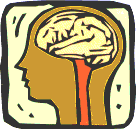The Amazing Color-Seeing
Brain
It may sound like a really simple question for us to ask, "how do we see
colors of light. All of us probably have some awareness of the fact that
our eyes have cones that we use to receive color information. What we may
not realize is that light itself actually has no color! Light is a
bundle of energy pulsating at a particular frequency, but has no color at
all. The sensation of color is generated in the mind--not in the physical
world.
 The answer to the color question is in the brain. When a particular frequency
is received in the sight part of the brain, a mental image is generated that
we call color. The brain does this, not the light. The color spectrum is
merely symbolic of the various wavelengths that we sense. Our brain takes
the response that comes from the eyes and forms a color image for us. Our
eyes see best (get the strongest signal) in the green (waves between 6 x 1012
pulses of energy and 5.646 x 1012 pulses of energy per second).
The brain can formulate 50 hues of color in this green section from yellowish
green to bluish green or aquamarine. In the red and blue energies, our vision
is much poorer.
The answer to the color question is in the brain. When a particular frequency
is received in the sight part of the brain, a mental image is generated that
we call color. The brain does this, not the light. The color spectrum is
merely symbolic of the various wavelengths that we sense. Our brain takes
the response that comes from the eyes and forms a color image for us. Our
eyes see best (get the strongest signal) in the green (waves between 6 x 1012
pulses of energy and 5.646 x 1012 pulses of energy per second).
The brain can formulate 50 hues of color in this green section from yellowish
green to bluish green or aquamarine. In the red and blue energies, our vision
is much poorer.
How much of your world is green? Think of all the foods you eat that
are green and how you tell a ready-to-eat leaf or vegetable from one that
is not ready to eat yet? How do you tell the difference between poison ivy
and maples or English ivy? Is it not incredible to realize that our eyes
do not really see, but that our brain is the real organ of vision? When we
say, "don't you see my point of view?" we unconsciously verify our understanding
of how marvelously we are made. Our minds are a precious creation of God
reflecting our capacity to love as well as to enjoy the beauty of all that
surrounds us. The Psalmist said it best:
"I will praise the Lord, for I am fearfully and wonderfully made:...
and that my soul knoweth right well" (Psalm 139:14).
--Reference: Astronomy, March 2001, page 85
Back to Contents Does God Exist?, NovDec02.
 The answer to the color question is in the brain. When a particular frequency
is received in the sight part of the brain, a mental image is generated that
we call color. The brain does this, not the light. The color spectrum is
merely symbolic of the various wavelengths that we sense. Our brain takes
the response that comes from the eyes and forms a color image for us. Our
eyes see best (get the strongest signal) in the green (waves between 6 x 1012
pulses of energy and 5.646 x 1012 pulses of energy per second).
The brain can formulate 50 hues of color in this green section from yellowish
green to bluish green or aquamarine. In the red and blue energies, our vision
is much poorer.
The answer to the color question is in the brain. When a particular frequency
is received in the sight part of the brain, a mental image is generated that
we call color. The brain does this, not the light. The color spectrum is
merely symbolic of the various wavelengths that we sense. Our brain takes
the response that comes from the eyes and forms a color image for us. Our
eyes see best (get the strongest signal) in the green (waves between 6 x 1012
pulses of energy and 5.646 x 1012 pulses of energy per second).
The brain can formulate 50 hues of color in this green section from yellowish
green to bluish green or aquamarine. In the red and blue energies, our vision
is much poorer.